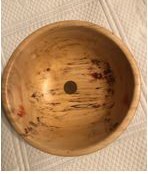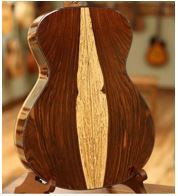AgEBB-MU CAFNR Extension
Green Horizons
Volume 22, Number 1
Winter 2018
Agroforestry
The Beauty and the Beastly Wood Villains
By Lynn Barnickol| Actually Wood LLC and Executive Director, Missouri Consulting Foresters Association
Wood turners, furniture makers, luthiers, architects, and saw millers are likely familiar with spalted wood and seek it for special one-of-a-kind bowls, pieces of furniture, guitars, and other stringed musical interments. Spalted wood is eye-catching, peaking folk's curiosity about the unique figure, and wondering if the woodworker has studied art.
Spalting is a natural condition in most woods. It's formed by competing fungi and is a continuum of decay from its initial or incipient stage of infection to complete destruction of wood. The pale colored hardwoods that frequently become spalted include hard and soft maple, sycamore, birch, cottonwood, hackberry, and beech.
The dark lines, white pockets, and pigments of spalted sapwood of most trees can be easily seen. However, in the heartwood of walnut and other dark colored woods, spalting is difficult to see. The extractives in the heartwood of walnut, white oak and other durable woods may slow the spalting process. Spalting occurs in conifers, like pine, spruce, fir, and others.
 |
A spalted boxelder bowl featuring black zone lines and pigmentation. White pockets do not appear as the spalting process was halted prior to that stage of the decay process. The pink color located at the lower left is from the boxelder stain fungus. (Actually Wood LLC) |
Certain species of fungi, typically soft and white rots, attack wood causing the pigmentation, white pockets, and zone lines. The competing spalting fungi are destructive and can invade both the wood and live trees that are stressed. The visual image created is that of the lair of a crazy science fiction villain. While the process of rotting is destructive, it is also a process of creating the spalted character in wood that's in the initial stages of decay. As spalting fungal activity progresses, it becomes detrimental to the structure, hardness, and strength of the wood.
The spalting fungi causing pigmentation of wood cells, one of the competing "beastly villains", is a soft rot. The fungi deposits black, red, brown pigments within the wood, most likely in the lumen of wood cells. Sometimes associated with spalting is blue stained sapwood and the pink-red color in boxelder. Those are stains caused by other types of fungi and do not destroy the wood. However, blue stain is an indication that conditions are suited for the growth of many wood destroying fungi. Although blue stain can add character to wood, it's considered a defect in high value lumber grades.
White pockets develop from a white rot fungus, and are another "villain". The feature is whitish as the cellulose of the wood remains after the fungus eats lignin and some of the hemicellulose fraction of wood. Lignin is the natural binder that helps hold wood fibers together. Spalting white rots are one of the fungi that, if left unchecked, results in the destruction of the wood.
Appearing as artistically created features, the fine, inky lines and streaks that have eye appeal represent boundaries or zones of competing fungi. Multiple lines are created as the fungi expand through the wood.
 |
Light colored spalted sugar maple accents and contrasts the dark color of cocobolo on the back of an expensive, custom order Taylor Guitar - GC Adirondack/Cocobolo (Shoreline Music Durango, CO). |
While the lines and streaks do not rot the wood, the fungi within the zones are guilty of causing rot.
Spalting can be detrimental to sawn wood and the way to combat it is to follow proper handling of the lumber. Processing logs soon after harvest prevents the sapwood from degrading. Keeping large supplies of expensive logs piled at the mill under a spray system literally drowns the fungi.
Once sawed into lumber, it needs to be stickered, so air movement begins the air-drying process. The heat and declining moisture content of lumber being kiln dried effectively bakes the fungi, stopping decay from advancing. Like a re- occurring nightmare, spalting fungi can establish in kiln dried lumber if it is improperly stored where high humidity and temperatures favor fungal growth.
Spalting can be detrimental to stressed trees. Spalting can cause disruption of moisture and nutrient movement in the sapwood leading to additional stress on the tree and its death. Using forestry practices to maintain a healthy forest is the best recommendation for prevention. Planned thinning projects help the retained trees maintain their health and vigor.
Potentially stressed trees have compacted crowns that do not receive enough sunlight or those having bare limbs that are in full sunlight and should be in full leaf. Trees wounded by storms or by other causes should be removed as part of a timber harvest or in planned thinning.
If you are thinking of trying to spalt some logs at home, in hopes of getting a premium price, you are more likely to impress timber buyers and loggers with your supply of large diameter, free of defect, healthy trees. Other than firewood logs, foresters have not reported witnessing truckloads of decaying logs heading to a mill for processing into lumber and other valuable products. Discussing the sale of spalted or decaying wood to a buyer or logger is likely to turn the conversation toward locating and subduing the "beastly villain" that has somehow invaded your woodlot.
Spalting logs and freshly sawed lumber on your farm or woodworking shop is tricky, as humidity, temperature, darkness, and time are variables. Providing a source of the fungi is not needed as it's typically in the air. Like raising mushrooms, spalting is a similar process: Control the temperature, humidity, air movement, and keep your project in the dark. The result may only be moldy lumber, or at worst too much rot, making the wood too soft to work. A quick and gambler's luck-of-the-draw method is simple: Place some logs or lumber in a pile of leaves or wet sawdust. Keep the experiment damp and frequently check the tell-tale black zone lines or pockets of white rot and associated pigmentation and stains. Science, art, and luck are needed in creating the spalted condition without allowing soft and white rots to progress to the point of ruining the wood.
If you are thinking of taking up woodworking and want to try using some spalted wood, there are a couple of considerations. There is some danger to your sinuses from processing spalted wood, but it's typically a reaction to dust from lathe turning, sawing or sanding. Using an approved dust mask for woodworking to reduce the possible reaction to dust is best. A second caution using spalted wood utensils is that it's not guaranteed to be food safe. Serving your favorite crackers in a spalted bowl is not a serious problem since spalted wood has been processed, dried, and a food-safe finish applied, the fungi are dead. Additionally, spores are only produced by living fungi that must be in an environment having suitable temperature and high humidity where the moisture content of the wood is above 20 to 30 percent. The moisture content is most homes is in the 8 to 12 percent moisture range. Like Goldilocks and the three bears, the porridge, or wood in this story, cannot be too wet or too dry nor too cold or too hot.
White pockets and the pigmentation that are formed within pen and ink zone lines are the "villains" that provide spalted wood its unique character. Spalted wood is featured in specialty markets for wood turners, accent pieces in furniture, and one-of-a-kind stringed musical instruments and bowls. Its beauty is in the eyes of the beholder. Spalted wood is naturally occurring, is rarely found, in demand, and is the result of environmental conditions allowing fungal activity to work its magic.
Note: If you want to try your luck with spalting some wood the following is a helpful publication called TechLine that is from the US Forest Service Forest Products Lab: https://www.fpl.fs.fed.us/documnts/techline/producing-spalted-wood.pdf
Use the key-words: "Spalting Wood" to find additional publications.
 |
Spalted panels on the headboard and side tables add character and interest to a cherry bed set. However, the beauty of spalted wood may not be appealing to some folks. (Amana Furniture Shop, Amana, IA). |
